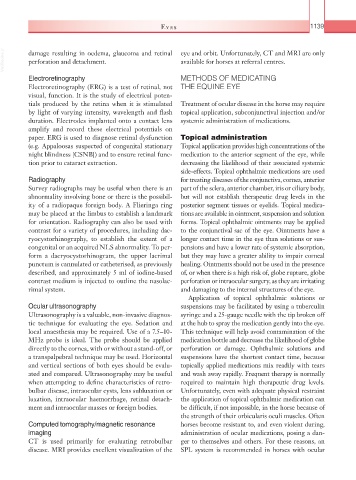Page 1164 - Equine Clinical Medicine, Surgery and Reproduction, 2nd Edition
P. 1164
Eyes 1139
VetBooks.ir damage resulting in oedema, glaucoma and retinal eye and orbit. Unfortunately, CT and MRI are only
available for horses at referral centres.
perforation and detachment.
Electroretinography METHODS OF MEDICATING
Electroretinography (ERG) is a test of retinal, not THE EQUINE EYE
visual, function. It is the study of electrical poten-
tials produced by the retina when it is stimulated Treatment of ocular disease in the horse may require
by light of varying intensity, wavelength and flash topical application, subconjunctival injection and/or
duration. Electrodes implanted onto a contact lens systemic administration of medications.
amplify and record these electrical potentials on
paper. ERG is used to diagnose retinal dysfunction Topical administration
(e.g. Appaloosas suspected of congenital stationary Topical application provides high concentrations of the
night blindness [CSNB]) and to ensure retinal func- medication to the anterior segment of the eye, while
tion prior to cataract extraction. decreasing the likelihood of their associated systemic
side-effects. Topical ophthalmic medications are used
Radiography for treating diseases of the conjunctiva, cornea, anterior
Survey radiographs may be useful when there is an part of the sclera, anterior chamber, iris or ciliary body,
abnormality involving bone or there is the possibil- but will not establish therapeutic drug levels in the
ity of a radiopaque foreign body. A Flieringa ring posterior segment tissues or eyelids. Topical medica-
may be placed at the limbus to establish a landmark tions are available in ointment, suspension and solution
for orientation. Radiography can also be used with forms. Topical ophthalmic ointments may be applied
contrast for a variety of procedures, including dac- to the conjunctival sac of the eye. Ointments have a
ryocystorhinography, to establish the extent of a longer contact time in the eye than solutions or sus-
congenital or an acquired NLS abnormality. To per- pensions and have a lower rate of systemic absorption,
form a dacryocystorhinogram, the upper lacrimal but they may have a greater ability to impair corneal
punctum is cannulated or catheterised, as previously healing. Ointments should not be used in the presence
described, and approximately 5 ml of iodine-based of, or when there is a high risk of, globe rupture, globe
contrast medium is injected to outline the nasolac- perforation or intraocular surgery, as they are irritating
rimal system. and damaging to the internal structures of the eye.
Application of topical ophthalmic solutions or
Ocular ultrasonography suspensions may be facilitated by using a tuberculin
Ultrasonography is a valuable, non-invasive diagnos- syringe and a 25-gauge needle with the tip broken off
tic technique for evaluating the eye. Sedation and at the hub to spray the medication gently into the eye.
local anaesthesia may be required. Use of a 7.5–10- This technique will help avoid contamination of the
MHz probe is ideal. The probe should be applied medication bottle and decrease the likelihood of globe
directly to the cornea, with or without a stand-off, or perforation or damage. Ophthalmic solutions and
a transpalpebral technique may be used. Horizontal suspensions have the shortest contact time, because
and vertical sections of both eyes should be evalu- topically applied medications mix readily with tears
ated and compared. Ultrasonography may be useful and wash away rapidly. Frequent therapy is normally
when attempting to define characteristics of retro- required to maintain high therapeutic drug levels.
bulbar disease, intraocular cysts, lens subluxation or Unfortunately, even with adequate physical restraint
luxation, intraocular haemorrhage, retinal detach- the application of topical ophthalmic medication can
ment and intraocular masses or foreign bodies. be difficult, if not impossible, in the horse because of
the strength of their orbicularis oculi muscles. Often
Computed tomography/magnetic resonance horses become resistant to, and even violent during,
imaging administration of ocular medications, posing a dan-
CT is used primarily for evaluating retrobulbar ger to themselves and others. For these reasons, an
disease. MRI provides excellent visualization of the SPL system is recommended in horses with ocular

